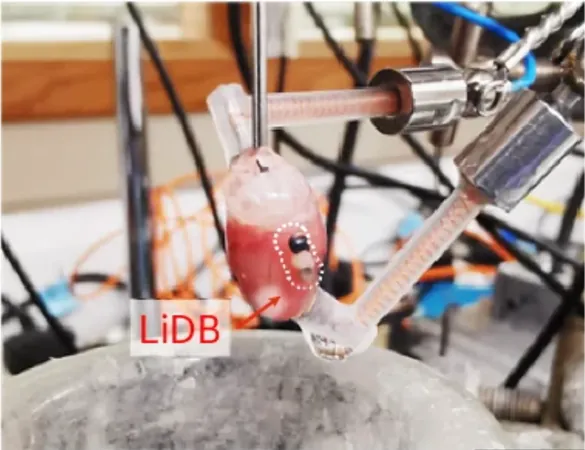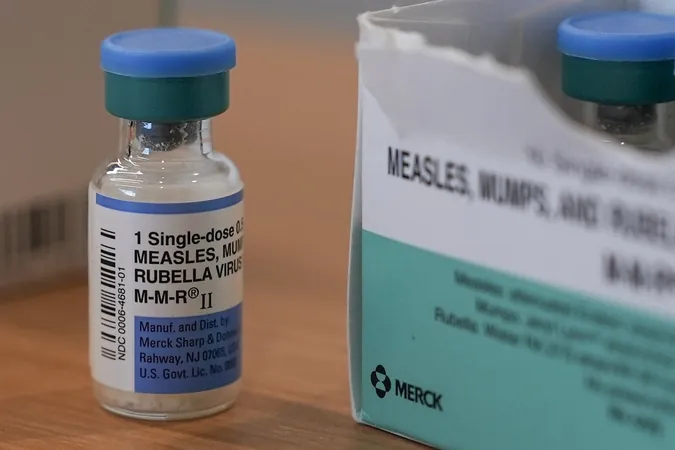
Revolutionary Mini Lithium Battery: The Future of Biocompatible Energy
2025-04-12
Author: Amelia
Tiny Breakthroughs, Massive Potential
Imagine a battery smaller than a grain of rice that not only powers living tissues but can also support synthetic cells and even move on its own! Researchers have recently unveiled a groundbreaking miniature lithium-ion battery crafted from biocompatible hydrogel, marking a remarkable leap in biotechnological innovation.
A Game-Changer for Medical Technology
As the quest for smaller and safer electronics accelerates, this droplet-sized marvel is set to transform the medical landscape. Picture medical devices that seamlessly integrate into the human body, enhancing functions like heart rhythm without leaving a trace. This ingenious battery, featuring droplets as tiny as 10 nanoliters, might just be the key.
Meet the LiDB: A Soft, Powerful Source of Energy
The newly developed lithium-ion battery, aptly named LiDB, addresses one of the key challenges of miniaturization—ensuring that power sources can remain soft, flexible, and compatible with biological systems. Unlike traditional batteries that are rigid and potentially harmful, the LiDB is biodegradable, rechargeable, and even activated by light.
Created in the Lab of Innovation
Crafted by scientists at the University of Oxford using a specially formulated silk-based hydrogel, the battery consists of three droplets that work harmoniously. The two outer droplets host different lithium-based particles while the central droplet facilitates ion movement to generate electricity.
Power Beyond Size: A New Era of Artificial Intelligence
This pint-sized powerhouse has demonstrated astonishing capabilities. It has successfully powered the movement of charged molecules in artificial cells, effectively mimicking biological communication. In an eye-opening experiment, this tiny battery managed the beating and defibrillation of a mouse heart, hinting at potential future applications in treating real heart conditions.
The Future of Heart Health?
The implications for cardiac care are particularly thrilling. With heart rhythm disorders claiming millions of lives annually, the LiDB promises a wireless solution for pacemakers and defibrillators that currently rely on bulky batteries, which often require surgical replacements.
A Vision for Tomorrow's Medical Devices
What's even more fascinating? The ability to integrate magnetic particles into the battery could allow it to navigate within fluid environments autonomously, delivering energy precisely where needed—ideal for tiny robots or responsive medical devices.
A Leap Towards Smarter Implants
Current advances in biocompatible devices at Oxford are paving the way for a future packed with soft, intelligent solutions capable of repairing bodily issues internally. The potential applications are staggering, including the possibility of sensors that dissolve after use, drastically reducing the need for invasive procedures.
Opening Doors to Personalized Medicine
Envision a world where soft electronics personalize treatment options tailored to individual patient needs with minimal invasiveness. The LiDB's capacity for wireless control opens new frontiers in remote medical interventions.
The Dawn of a New Era in Medical Technology
From stabilizing heartbeats to powering synthetic life, this miniature battery signifies a major shift in how we approach energy for medical devices. By embracing these minuscule, intelligent systems that safely vanish after completing their tasks, the future of healthcare looks brighter than ever.
Conclusion: A New Dawn of Innovation
With patents already filed, researchers are eager to bring this revolutionary technology closer to clinical reality. Step into a future where medical devices shrink and smartly adapt, proving that even the tiniest innovations can pack a powerful punch!









 Brasil (PT)
Brasil (PT)
 Canada (EN)
Canada (EN)
 Chile (ES)
Chile (ES)
 Česko (CS)
Česko (CS)
 대한민국 (KO)
대한민국 (KO)
 España (ES)
España (ES)
 France (FR)
France (FR)
 Hong Kong (EN)
Hong Kong (EN)
 Italia (IT)
Italia (IT)
 日本 (JA)
日本 (JA)
 Magyarország (HU)
Magyarország (HU)
 Norge (NO)
Norge (NO)
 Polska (PL)
Polska (PL)
 Schweiz (DE)
Schweiz (DE)
 Singapore (EN)
Singapore (EN)
 Sverige (SV)
Sverige (SV)
 Suomi (FI)
Suomi (FI)
 Türkiye (TR)
Türkiye (TR)
 الإمارات العربية المتحدة (AR)
الإمارات العربية المتحدة (AR)